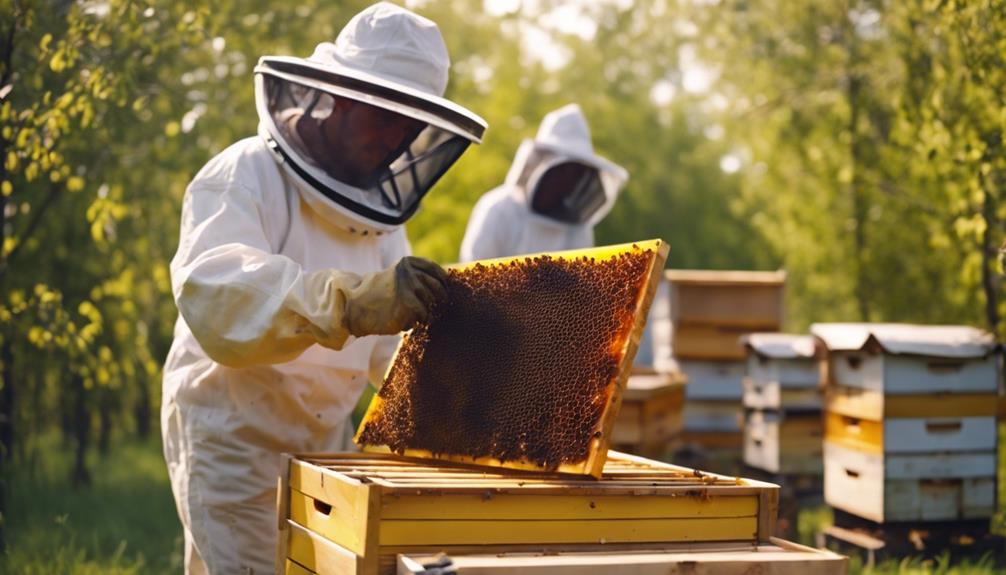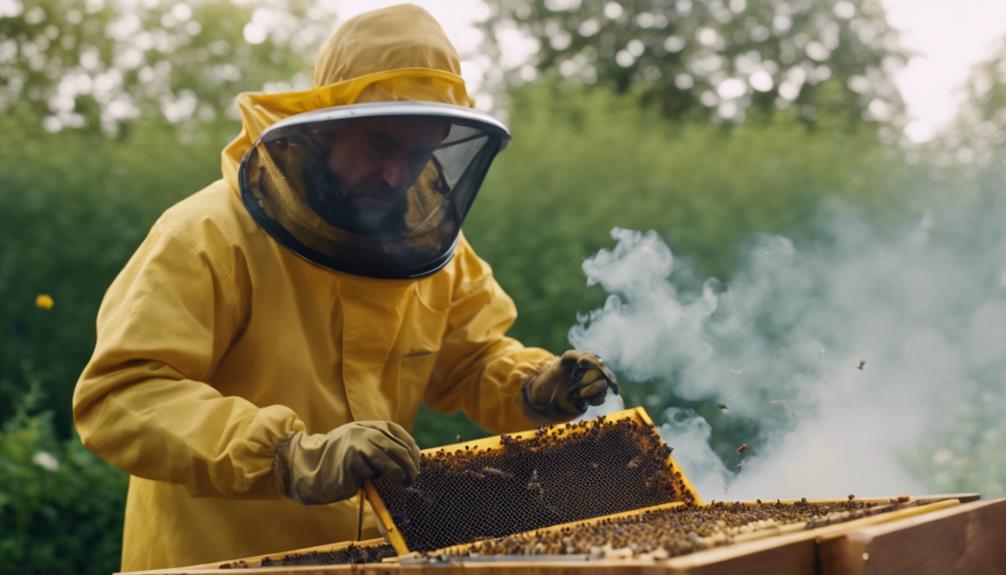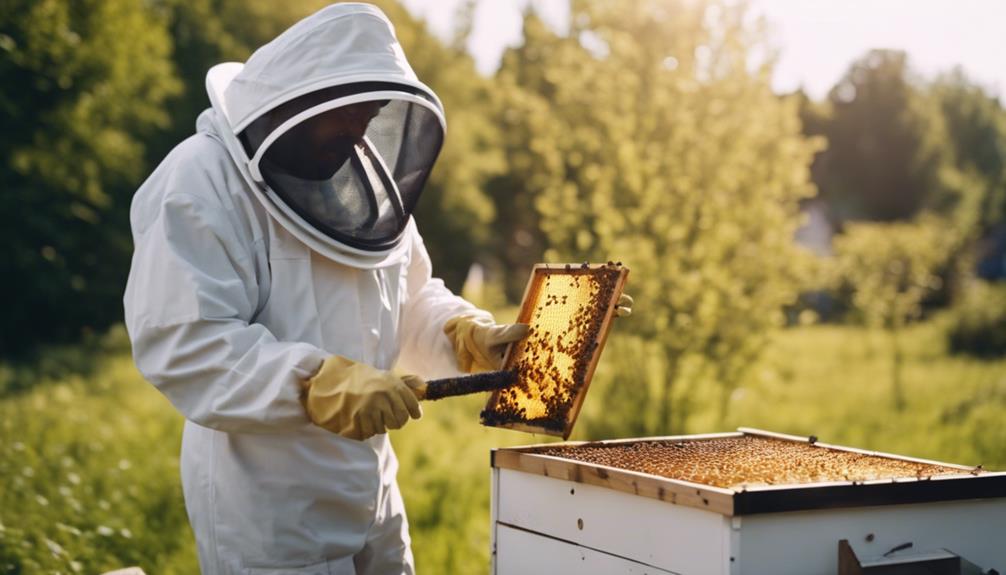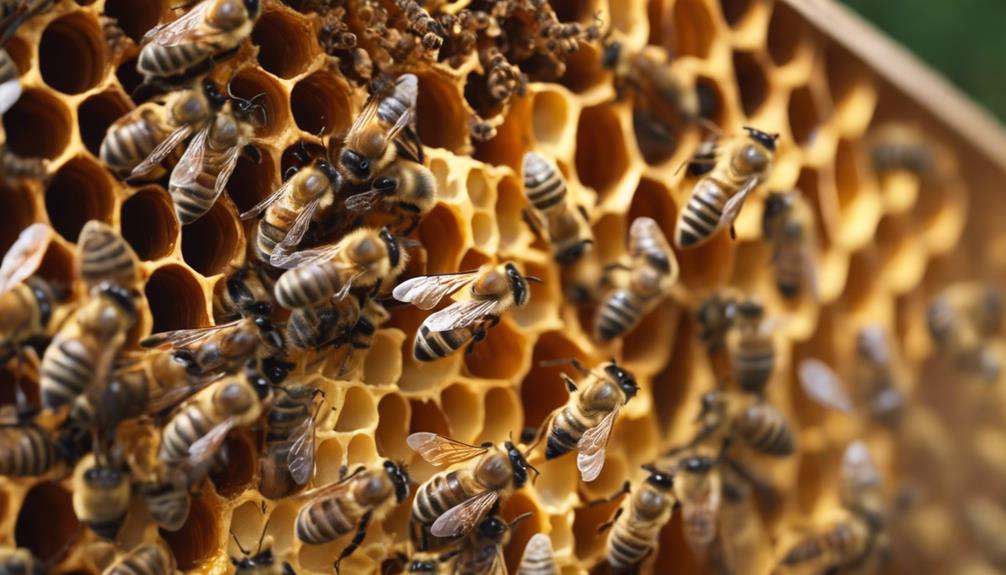When it pertains to harvesting honey, we wait until about 90% of the honeycomb cells are capped for that perfect sweetness. It’s crucial to strike a balance between harvesting and leaving enough honey for our hardworking bees to survive winter. Using an extractor helps make the extraction process smoother. Remember, strong colonies may need more frequent harvesting to keep them thriving. Techniques like crush and strain can also come in handy. And if you’re curious to know more about successful honey harvesting, stick around for some valuable tips and tricks!
Main Points
- Wait until cells are 90% capped for sweetness.
- Use extractor for efficient honey extraction.
- Leave enough honey for bees’ winter survival.
- Consider bee protection during harvest.
- Find balance between harvesting and bees’ needs.
Timing and Considerations for Harvesting
When preparing to harvest honey, it’s important to consider the timing and various factors that can impact the process. We need to wait until the honeycomb cells are about 90% capped to guarantee the honey is at its best sweetness for extraction.
Additionally, considering bee protection is key to guarantee a smooth and successful harvest. By being mindful of our buzzing friends, we can make the process easier for both parties. Furthermore, leaving enough capped honey for the bees is crucial for their winter survival. It’s all about finding that balance between harvesting what we need and ensuring the bees have ample resources to thrive during the colder months.
And with regard to actually extracting honey, methods like using an extractor can make the task efficient and enjoyable.
Quantity Management for Winter Survival
To ensure the winter survival of bee colonies, meticulous management of honey quantities is essential. As responsible beekeepers, we must strike a delicate balance between harvesting honey and ensuring our bees have ample reserves to last through the colder months.
Strong colonies may need more frequent honey harvesting to prevent overcrowding, but it’s essential to leave behind enough honey frames for their winter sustenance. It’s better to be cautious and leave extra honey than risk the bees not having enough. Determining the right quantity to harvest involves considering the needs for brood rearing and overall survival.
Hive Adaptations and Methods Overview

Hive adaptations and methods play an important role in facilitating the efficient harvesting of honey from different hive types. In the realm of beekeeping, being equipped with the right tools and techniques can make all the difference in the honey extraction process.
- Bees: Understanding bee behavior and biology is essential for successful honey harvesting.
- Wax Cappings: Properly managing and removing wax cappings is vital for accessing honey.
- Honey Extraction: Different methods like crush and strain can be used to extract honey from the comb.
- Adaptations: Utilizing tools such as bee escapes and blowers can help in managing bees during the harvest.
Techniques for Honey Processing
Understanding the techniques for honey processing improves the efficiency of honey extraction and guarantees high-quality results. Using a hot knife, delicately remove wax cappings from honeycomb cells to access the liquid gold inside.
Employ a honey extractor to separate the liquid honey from the comb without causing damage, ensuring a smooth extraction process. If you prefer a different method, consider crushing and straining the honey-filled comb as an alternative extraction technique.
Remember to allow the liquid honey to settle before bottling to boost its quality further. Don’t forget to repurpose the beeswax from the extraction process; it’s perfect for crafting candles or homemade lip balm.
These techniques guarantee you get the most out of your honey harvest while maintaining its purity.
Importance of Proper Equipment and Techniques

When harvesting honey, having the right equipment and mastering proper techniques is vital for a successful and rewarding experience. Here are some key points to ponder:
- Invest in Quality: Quality equipment like an uncapping knife and honey extractor is essential for efficient honey harvesting.
- Handle with Care: Using the right techniques, such as gentle uncapping and proper spinning in the extractor, guarantees high-quality honey extraction.
- Prevent Damage: Well-maintained equipment helps avoid damage to honeycomb cells during the harvesting process.
- Success Tips: Following best practices in equipment maintenance and usage leads to a productive honey harvest, resulting in high-quality honey for your enjoyment.
Educational Resources and Support
Exploring beekeeping basics and refining your honey extraction techniques is essential. Finding educational resources and support is crucial. From reaching out to experienced beekeepers for practical advice to enrolling in online courses for a deeper understanding, there’s a wealth of knowledge waiting to be discovered.
Beekeeping Basics
To master the art of beekeeping, tapping into educational resources and seeking support from experienced beekeepers is essential. Here are some key beekeeping basics to get you started:
- Join beekeeping associations or workshops to learn from experienced beekeepers.
- Read beekeeping books and watch instructional videos for valuable insights.
- Choose the right location for your hives based on sunlight, water sources, and protection.
- Properly inspect beehives regularly to monitor bee health and hive conditions.
Honey Extraction Techniques
Exploring educational resources and seeking support from experienced beekeepers is crucial when diving into honey extraction techniques. Using a hot knife to delicately remove wax cappings from honeycomb cells guarantees a clean extraction process.
Consider investing in a honey extractor for effectively separating liquid honey from the comb without causing damage. Alternatively, crushing and straining honey-filled comb can be a simple yet effective method. It’s important to allow the liquid honey to settle before bottling to achieve a clearer final product.
Additionally, repurposing beeswax from extraction not only minimizes waste but also offers opportunities for creative projects like making candles. By mastering these techniques, you can efficiently harvest honey while caring for your honey bees and their home.
Bee Protection Measures

In harvesting honey, our safety is paramount. We always outfit ourselves with protective clothing – suits, veils, and gloves are our best allies against bee stings.
Employing a smoker to pacify our buzzing friends before collecting the honey is essential to maintain harmony.
Protective Gear Basics
We always make sure to wear a beekeeping suit, gloves, and veil for full body protection against bee stings when harvesting honey. Here are some tips to guarantee proper bee protection measures:
- Use light-colored clothing to avoid attracting bees.
- Tuck in your clothing and seal any gaps to prevent bees from getting inside.
- Consider using leather or thick gloves for added hand protection during hive inspection.
- Regularly check and maintain your protective gear to ensure safety while working with bees.
Protective gear is essential for keeping us safe during hive activities, and by following these simple steps, we can enjoy the freedom of harvesting honey without worrying about bee stings.
Importance of Smoke
To guarantee our safety and optimize hive inspections, understanding the importance of smoke as a bee protection measure is vital. When we make sure to use smoke properly during hive inspections, we protect both the bees and the beekeeper.
The application of smoke interferes with the bees’ sense of smell, which in turn calms them down and reduces their defensive behavior. By masking the alarm pheromones released by guard bees, smoke helps prevent the bees from becoming agitated and aggressive. This distraction allows us, beekeepers, to work more efficiently and safely.
Tips for Successful Honey Harvesting
For successful honey harvesting, it’s crucial to meticulously monitor the hive’s honey reserves and plan the extraction process accordingly. Here are some key tips to guarantee a successful harvest:
- Watch educational videos on harvesting techniques for practical guidance.
- Seek advice from local beekeeping organizations for specific tips.
- Guarantee bees have enough honey for winter survival.
- Protect honeycomb from pests and contamination during extraction.

Hello! My name is Noel Calvin. I graduated from UCLA and now work as a writer at Launch Ninjas. I write blog posts that inspire and guide our readers in their entrepreneurial pursuits. I live in Pleasantville, NJ, with a peaceful yet lively atmosphere that inspires me.
Writing stories is more than just a job for me. It allows me to share my observations and satisfy my curiosity about the world. I combine my analytical skills with creative enthusiasm to delve into technology trends and startup stories. But my life isn’t limited to screens and keyboards. I value loyalty, passion, and a touch of old-fashioned charm, which I infuse into every narrative I create.
I love spending time in my garage, jamming with my band when I’m not writing. Playing the guitar and singing bring me immense joy. I also enjoy capturing ordinary and extraordinary moments through my camera lens and exploring new culinary adventures that excite my taste buds. I’m always seeking new experiences.
My family is very important to me. Joyful Sunday brunches filled with laughter and intense board game nights keep me grounded, reminding me of life’s simple pleasures.
In my world, every moment is an opportunity for discovery. Every discovery is a story worth sharing, whether a heartfelt moment at home or the pulse of technological innovations. Join me as I navigate through life, one blog post, one guitar strum, and one heartwarming family dinner at a time.


